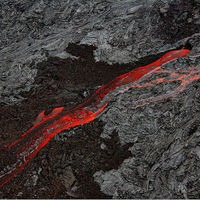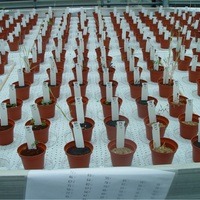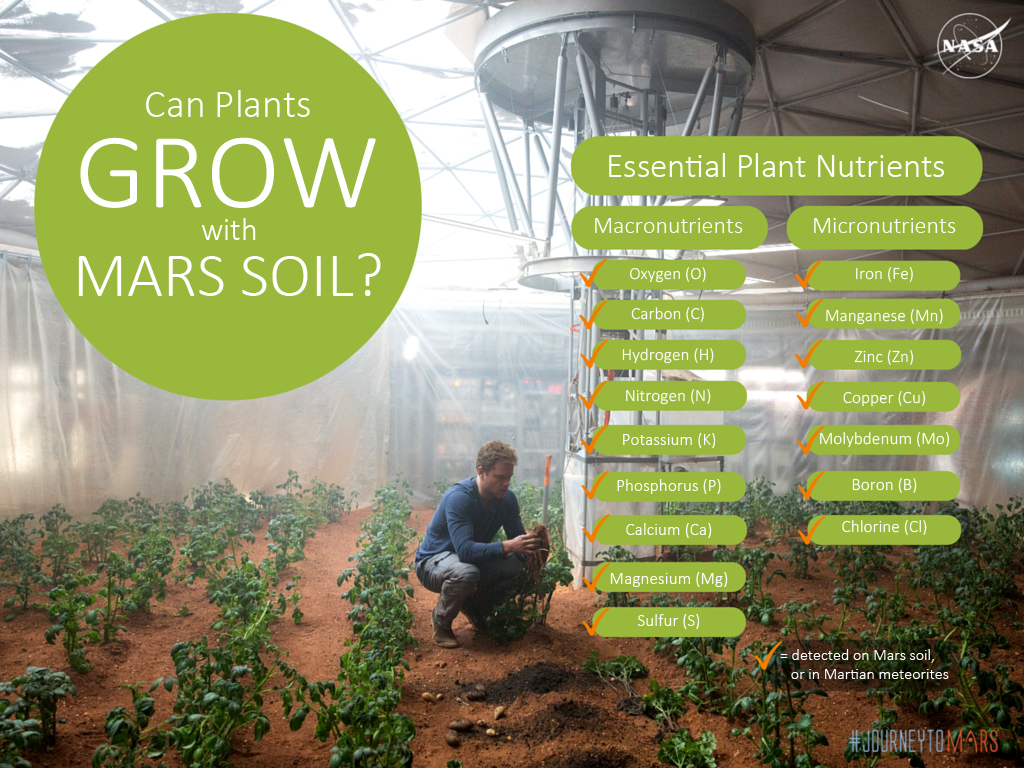Of Mars and Minerals
In “The Martian,” Mark Watney uses the Martian soil to grow potatoes in the controlled environment of the “Hab.” In reality, the soil on Mars actually does have the nutrients plants would need to survive on Mars! There may not be the right amount of nutrients depending on where astronauts land on the Red Planet, so fertilizers may need to be added to the soil.
Gary Jordan, NASA Johnson Space Center
It is already well established that rock dust is crucial for soil remineralization here on Earth, but a growing body of work from scientists at NASA and elsewhere has demonstrated an unexpected application for rock dust: simulating Martian soil. For the past few years, scientists have been using rock dust from Earth to mimic soil conditions on Mars to see whether crops can be grown on Mars. So far the results have been positive.

Pāhoehoe Lava and ʻAʻā flows at The Big Island of Hawaii. The picture was taken from a helicopter. (Photo credit: Brocken Inaglory)
Since there has not been a return mission from Mars, there are no Martian soil samples on Earth.[1] However, the various NASA landers and rovers have gathered a good deal of data about the chemical and mineral composition of soil on Mars. This has given them enough information to form a suitable artificial Martian soil. It turns out that crushed volcanic rock from certain volcanoes in Hawaii functions as an excellent Martian soil simulant.[2]

Block 2 of the experiment, with randomly placed pots, 14 days after the start of the experiment. Each block contains 42 pots. Block 12 is visible in the background. The labels in the pots show the pot number, the species (from left to right on the first row Yellow sweet clover (twice), Leopards bane, Field Mustard, Carrot and Red fescue) and the soil type (L for moon or Lunar, M for Mars and E for Earth) combined with the block number (2)
The question is whether the complex mineral composition of the simulant Martian soil can support plant growth. Experiments have tested whether this soil can support various different plant life, comparing it to some soil from Earth, as well as to simulated lunar regolith (which is also made from rock dust). The end result showed better plant growth in the Martian simulant than both lunar soil and Earth soil. Some Martian soil simulants have generated 50 days of plant growth without the addition of nutrients.
The hope is that the complex combination of minerals and elements in Martian soil (as outlined by NASA in [2]) will allow farming. The goal is to start with Nitrogen fixing plants, since Martian soil is low in nitrogen, and then to move on to other plants.[3] Eventually, it may be possible to create something like the garden created by Matt Damon’s character in Ridley Scott’s film The Martian. This novel application of rock dust shows once again the importance of a rich mineral composition to soil, perhaps even on Mars.
Of course, once agriculture is actually attempted on Mars itself, there will be numerous challenges to growing plants there: insufficient sunlight, harsh environment, too little water, and too little carbon.[4] However, the ease of amending the mineral content of the soil with rock dust is a benefit that may help a future Mars mission succeed.
Benjamin T. Rancourt received his PhD in Philosophy from the University of Massachusetts Amherst in May 2016. His continuing philosophical research focuses on understanding, knowledge, and science, among other topics. This research ties into his wider goal of encouraging deeper understanding of ourselves, our strengths, and our limitations. He hopes that greater understanding will help us use the resources available to us to preserve what is good and address what is wrong. Walking is his primary mode of transportation. He appreciates the natural world. He lives in Northampton, Massachusetts with his wife Julia.
Appendix
[1] NASA is currently planning a mission to send a rover to Mars to study the soil in much greater depth. The mission is scheduled to launch in 2020, according to [3].
[2] The study [4] made this soil simulant.
[3] Astronauts on Mars may have to begin with hydroponics in order to get enough plant life to successfully start crop growth on Mars. See [2] for more details.
[4] NASA describes some of these issues in [1].
References
[1] Herridge, L. (2016) NASA Plant Researchers Explore Question of Deep-Space Food Crops. http://www.nasa.gov/feature/nasa-plant-researchers-explore-question-of-deep-space-food-crops[2] Jordan, G. (2015) Can Plants Grow with Mars Soil? http://www.nasa.gov/feature/can-plants-grow-with-mars-soil
[3] NASA (2014) 2020 Mission Plans. http://mars.nasa.gov/programmissions/missions/future/mars2020/
[4] Wieger Wamelink, G. W.; et al (2014) Can Plants Grow on Mars and the Moon: A Growth Experiment on Mars and Moon Soil Simulants? PLOS One, Vol. 9, Issue 8. http://journals.plos.org/plosone/article/asset?id=10.1371%2Fjournal.pone.0103138.PDF
Support us on Patreon
Thank you for joining us today! Please become a member of RTE and support us on Patreon. Unlike many larger organizations, we work with a team of determined and passionate volunteers to get our message out. We aim to continue to increase the awareness of remineralization to initiate projects across the globe that remineralize soils, grow nutrient dense food, regenerate our forests’ and stabilize the climate – with your help! If you can, please support us on a monthly basis from just $2, rest assured that you are making a big impact every single month in support of our mission. Thank you!








Got something to say?